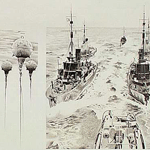
NPS/Harpers Ferry Center Commissioned Artwork. Fort Wadsworth continued in its defense of New York Harbor until 1945. During World War I, soldiers assigned to Fort Wadsworth manned the fort's guns and were also sent on a rotating schedule with soldiers from Fort Hamilton to the new Fort Tilden. After war's end the fort's command was changed from Coast Artillery to Infantry. This was due to the advances in naval weaponry that allowed their range to exceed any response from a disappearing gun. The Army chose not to build new batteries on fixed barbette carriages at Fort Wadsworth like they were building at Fort Tilden and Fort Hancock. A caretaker detachment of Coast Artillery soldiers remained to maintain the remaining coastal weaponry. Fort Wadsworth's defenses were augmented with the addition of anti-aircraft guns in the 1930s. During World War II, operational control of the Fort was returned to the Coast Artillery. The main defenses were however, anti-aircraft and not seacoast guns. Fort Wadsworth did continue to maintain the underwater mine defenses. Used in conjunction with Battery Turnbull and its remaining four 3-inch guns, this battery was the last to remain at Fort Wadsworth. Its guns were removed at war's end. Fort Wadsworth was the location of the HECP or Harbor Entrance Command Post. From here, the Army and Navy identified ships and controlled shipping into New York Harbor. |
Last updated: February 26, 2015
